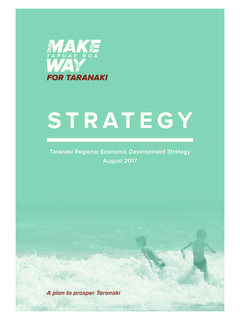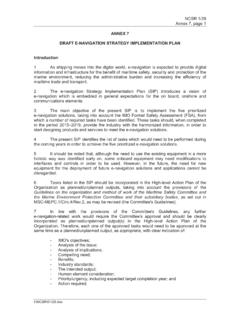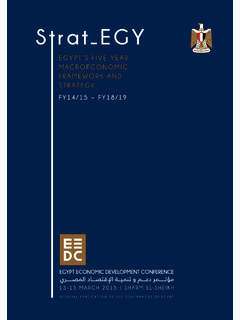Transcription of The 2018 National Defense Strategy
1 CRS INSIGHTThe 2018 National Defense StrategyFebruary 5, 2018 (IN10855)|Related AuthorKathleen J. McInnis|Kathleen J. McInnis, Analyst in International Security 7-1416)On January 19, 2018 , Secretary of Defense Mattis released the unclassified summary of theDepartment of Defense 's (DOD) first congressionally mandated National Defense Strategy (NDS). In addition to stating DOD's approach to contending with current and emergingnational security challenges, the NDS is also intended to articulate the overall strategicrationale for programs and priorities contained within the FY2019-FY2023 budget , the document maintains that the strategic environment in which the United Statesmust operate is one characterized by the erosion of the rules-based international order, whichhas produced a degree of strategic complexity and volatility not seen "in recent memory"(p.
2 1). As a result, the document argues, the United States must bolster its competitive militaryadvantage which the NDS sees as having eroded in recent decades relative to the threatsposed by China and Russia. It further maintains that "inter-state strategic competition, notterrorism, is now the primary concern in National security." (p. 1)Statutory RequirementParticularly since the end of the Cold War, the Pentagon has regularly reviewed its Strategy ,policy, and programs to ensure they are appropriate to the current and emerging strategiclandscape. Over time, these reviews became congressionally mandated and referred to as the"Quadrennial Defense Review." Eventually, dissatisfaction with the QDR process and itsassociated outcomes led Congress to rewrite the requirements for these DOD strategydocuments. The FY2017 NDAA, 114-328, Section 941, amended Title 10, United StatesCode, Section 113, to require the Secretary of Defense to produce an NDS which articulateshow the Department of Defense will advance objectives articulated in the NationalSecurity Strategy , released in December 2017.
3 The document released on January 19threpresents a summary of the full NDS, which is itself the NDS SaysConsistent with comparable documents issued by prior administrations, the NDS maintainsthat there are five central external threats to interests: China, Russia, North Korea, Iran,and terrorist groups with global reach. The NDS mandate requires DOD to prioritize thosethreats. Accordingly, retaining the strategic competitive edge relative to China and Russiais viewed a higher priority than countering violent extremist organizations. Further, the NDSappears conceptually consistent with the National Security Strategy regarding the notion that"peace through strength," or improving the capability and lethality of the joint force in order todeter warfare, is essential to countering these threats. It also contends that, unlike most of theperiod since the end of the Cold War, the joint force must now operate in contested domainswhere freedom of access and maneuver is no longer such, it organizes DOD activities along three central "lines of effort" rebuilding militaryreadiness and improving the joint forces' lethality, strengthening alliances and attracting newpartners, and reforming the department's business practices and argues that all three areinterconnected and critical to enabling DOD to effectively advance objectives.
4 It alsonotes that programs designed to advance those objectives will be included in the FY2019-FY2023 budgets. Some further key points includeBuilding a more lethal joint force will require consistent multiyear investments toimprove war fighting readiness, an optimally sized joint force, prioritization ofpreparedness for war as part of an overall deterrent and competitive posture, and themodernization of key capabilities. The latter includes nuclear forces; space andcyberspace capabilities; command, control communications, computers and intelligence,surveillance and reconnaissance (C4 ISR) capabilities; missile Defense ; joint lethality incontested environments; forward maneuver and posture resilience; autonomous andunmanned systems; and resilient logistics (p. 6-7).Strengthening allies and attracting new partners will require better burden-sharingamongst allies; expanding regional consultative mechanisms and collaborative planning;and deepening interoperability amongst allies and partners (p.)
5 8-9).Reforming DOD for greater performance and affordability will require prioritizingspeed of capability delivery rather than the "exquisite" performance of systems andcapabilities; better organizing the Department to enable innovation to improve lethalityacross the joint force; better budget discipline and affordability; rapid prototyping andfielding of equipment; and harnessing and protecting the National Security InnovationBase (p 10-11). The NDS sees harnessing that base as a source of competitive advantagePotential Questions for CongressAs Congress considers the NDS, as well as the programmatic and resource decisions to beproposed by the Trump Administration to accomplish objectives contained within the Strategy ,it could consider the following points:What is the force sizing construct? The central conceptual underpinning of the NDS and all Defense Strategy reviews prior to it since the end of the Cold War is the "forcesizing construct" (FSC).
6 The FSC is, essentially, a heuristic that allows planners tojudge whether the size and composition of the military is sufficient to meet the nationalsecurity challenges facing the United States. What are the assumptions that went intothis FSC? Is the FSC an appropriate guide for building a joint force that can meet thenational security challenges the faces? How flexible is the construct over multiplepossible crises?What is the appropriate balance of investment between force size and capabilitymodernization? Secretary Mattis appears to prioritize capability modernization. Yetconcerns about force overstretch due to high operations tempos over the past 15 yearshave prompted some observers to note that investments in additional forces may benecessary, especially given that contending with any one of the 5 key National securitychallenges in the NDS might be significantly military manpower intensive.
7 How mightDOD raise such a force while maintaining its standards? How do the tradeoffs betweencapability and capacity relate to the threats and scenarios undergirding the NDS?Will the United States be able to retain its alliances in their current forms whileattracting new partners? One critical aspect of the strategic competition with Chinaand Russia is their respective abilities to cause other international actors to doubt, if notreject, leadership. Should the United States prove unable to counter thosechallenges to American influence, how might that impact DOD's ability to effectivelycompete with each? How reliant is the Strategy on our current allies and how might theUnited States seek to cultivate stronger and additional partners?What are the strategic and programmatic implications of the de-prioritization ofclimate change?
8 Climate change and its National security ramifications were explicitlyrecognized by the Obama Administration as factors affecting the future global securityenvironment and thus impacted capability and infrastructure investments. What, if any,programs or missions will be de-prioritized as a result of this decision? What are thesecurity implications of these choices if they are made?















